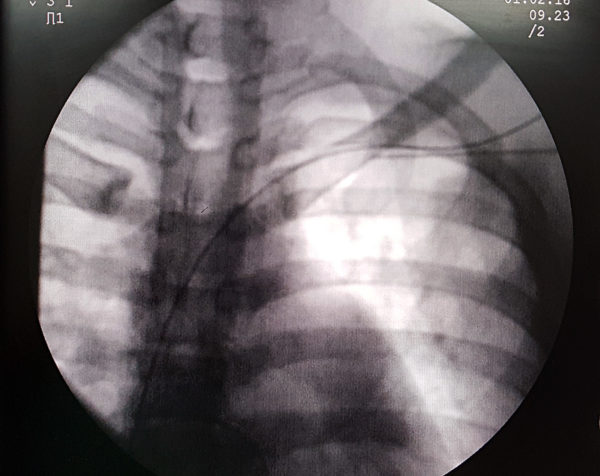Placement of additional guide-wires for multilead pacing
Inserting Additional Guide wires
There are two methods to gain additional guide wires to the venous system for pacing. First is to use the existing wire and piggy-back an additional wire (also called double wiring). The second method is to do additional venous punctures and gain access. The authors’ personal preference is to do additional punctures (see below as to why) but double wiring is a very useful backup method when punctured access is difficult or tricky.
The authors’ personal preference is to do additional punctures (see below as to why) but double wiring is a very useful backup method when punctured access is difficult or tricky.
Additional Punctures
Figure : Fluroscopically guided second puncture. Again the basic principle of not breaching the medial border of the first rib applies (in this example, the tip of the needle was just approaching the medial border when blood was aspirated
Video : Performing a second puncture. Note that the travel of needle is rather shallow when puncturing through the pocket and being medial or lateral to the existing wire depends on space
Additional punctures are done through the pocket floor, few millimeters away from the first guide. One must be careful with regard to depth, as puncturing through the pocket means shallow entry to the vein (compare to puncturing through skin). Once the second wire is in, its position is confirmed radiographically. The medial most wire is selected for the atrial lead sheath and clipped to the drapes and kept away. The sheath dilator set assembled, flushed and inserted along the free guide-wire thus establishing a sheath for the ventricular lead
The biggest advantage of performing an additional puncture is that adequate spacing can be gained between the future leads – i.e. increased longevity of leads by minimize inter-lead friction. When a double wiring technique is employed, technically, both guide-wires enter through a single venotomy and therefore the future leads lie very close together, raising the possibility of friction damage. However some international centers of excellence dispute this theory and perform double wiring almost exclusively. The most important benefit of double-wiring is that there is no added risk of a pneumothorax – which is not the case when doing a second puncture.
Double wiring method
Video : Piggy-back (double wiring) method for gaining additional wires in to the vein
In the piggy back (double wire) method, a sheath along with the dilator is passed over the existing guide-wire. Thereafter the dilator is removed while keeping the guide-wire and sheath insitu. Now the second guide wire is sent in parallel to the first guide-wire through the sheath thus ending up having two guide-wires within the sheath. Thereafter the sheath is taken out leaving two guide-wires in the vein and their positions confirmed flurospcically. The medial most wire is selected for the atrial lead sheath and clipped to the drapes and kept away. The sheath dilator set is re-assembled, flushed and re-inserted along the free guide-wire thus establishing a sheath for the ventricular lead. One potential acute drawback of using this method is that there may be para-lead leakage of blood as there is a large opening in the vein – this may require a purse string suture around the leads before closure of the pocket.
The author’s approach is to attempt a second puncture if the puncture for the first wire was easy and switch to double wiring if the second puncture proves to be difficult. Double wiring is also preferred in patients who are at higher risk of a pneumothroax. A second puncture is preferred if the initial guide-wire is appears “tight” and not supporting of two closely spaced leads. For dual chamber ICDs and CRTs separate punctures are preferred as lead thicknesses and sheaths vary.
